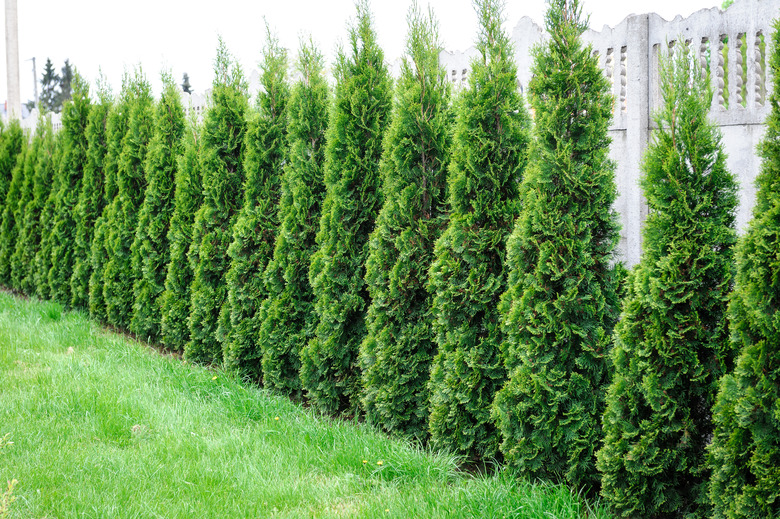What Is The Best Fertilizer For Arborvitae?
We may receive a commission on purchases made from links.
Well known for dependability and versatility, arborvitaes (Thuja spp.) enjoy widespread popularity in American landscapes. With varieties suitable for U.S. Department of Agriculture plant hardiness zones 2 through 8, arborvitaes range from diminutive spheres to stately, spreading trees. A favorite for hedges, screens, and low-maintenance landscapes, these undemanding evergreens ask little in return for lasting beauty. Arborvitaes rarely need supplemental fertilizer when sited properly and cared for well.
Starting New Arborvitae
Starting New Arborvitae
A main factor affecting the nutritional health of young or newly planted arborvitaes is proper location. These conifers tolerate light shade but thrive in full sun. They prefer moist, well-drained soil that retains moisture, yet releases excess water freely. Like most evergreens, arborvitae don't require any fertilization at planting time. Until roots begin to grow and get established, fertilizer could burn and damage tender new roots.
If desired, a small amount of well-composted manure can be added to the planting area to help condition soil and provide a gentle release of low-level nutrients. One inch of compost over the planting area, worked into the soil, is sufficient during the plant's first season.
Adjusting for Maturity
Adjusting for Maturity
When maturing arborvitaes retain healthy color and expected growth, supplemental fertilizers are optional. To speed growth, high-nitrogen fertilizers encourage green, leafy growth until younger plants reach desired size. Healthy arborvitae benefit most from annual fertilizer applied in early spring before new growth begins.
Use slow-release, granular fertilizer with a higher first number, such as 12-6-4 or 10-8-6. Broadcast granules at a rate of one-third pound for each foot of the plant's height. Water thoroughly, so fertilizer firmly contacts the soil and begins to work. Mature, healthy arborvitaes don't need extra fertilization. In lawn areas, turf fertilizers used close by add nutrients.
Managing Nutrition Through Care
Managing Nutrition Through Care
If your arborvitaes look unhealthy, don't turn to fertilizers first. Fertilizing stressed plants worsens problems and often leads to plant loss. Arborvitaes are sensitive to environmental imbalances. Anything that impairs root activity inhibits an arborvitae's ability to absorb fertilizer and soil nutrients.
Improper watering is a frequent culprit. Over-watering and under-watering shut down stressed roots, leaving them vulnerable to fertilizer damage. Check the soil around your arborvitae manually to ensure proper watering by digging down a finger's depth. Soil should be cool and moist, not dry or wet.
Water deeply when you water, then check before watering again. Plant needs vary with seasonal weather changes, so monitor the soil regularly.
Identifying Special Needs
Identifying Special Needs
If well-cared-for arborvitaes look sickly, conduct a soil test before adding all-purpose or specialty fertilizers. Arborvitaes flourish with soil pH at near-neutral levels of 6.0 to 8.0. Extreme pH levels, high or low, cause nutrient deficiencies and toxicities. In many cases, nutrients are present, but soil pH and other factors keep them from being usable by the plants.
In high-alkaline soil, arborvitaes suffer yellowing foliage from iron deficiency. Adding iron when already present, or in forms plants can't absorb, wastes iron and jeopardizes arborvitaes. A soil test confirms the real reason behind deficiency symptoms. Tell the testing laboratory you grow arborvitaes. They can tailor short- and long-term recommendations for your specific needs.
References
- University of Wisconsin Cooperative Extension: Evergreens – Planting and Care
- North Dakota State University Agriculture: American Arborvitae
- University of Minnesota Extension: Fertilizing Evergreens (Conifers)
- University of California IPM Online: Arborvitae — Platycladus Orientalis, Thuja Occidentalis; Western Red Cedar — Thuja Plicata; Family Cupressaceae (Cypress Family)
- Missouri Botanical Garden: Iron Chlorosis
- Missouri Botanical Garden: Thuja
